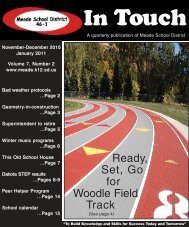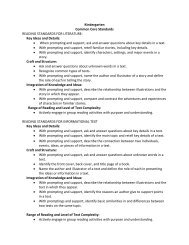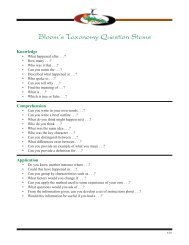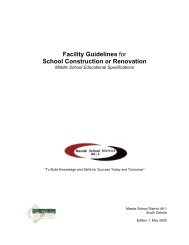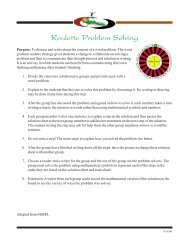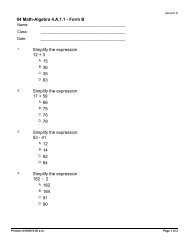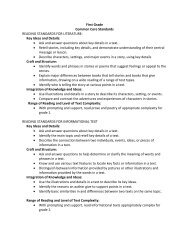Assessing Students' Affect Related to Assessment for Learning
Assessing Students' Affect Related to Assessment for Learning
Assessing Students' Affect Related to Assessment for Learning
Create successful ePaper yourself
Turn your PDF publications into a flip-book with our unique Google optimized e-Paper software.
<strong>Assessing</strong> Student’s <strong>Affect</strong> <strong>Related</strong> <strong>to</strong> <strong>Assessment</strong> <strong>for</strong> <strong>Learning</strong>W. James Popham and Rick StigginsASSESSING STUDENTS’ AFFECTRELATED TO ASSESSMENT FOR LEARNINGAN INTRODUCTION FOR TEACHERS*Rick Stiggins, ETS <strong>Assessment</strong> Training InstituteW. James Popham, UCLA<strong>Assessment</strong> <strong>for</strong> learning (AFL) represents a way <strong>for</strong>teachers and their students <strong>to</strong> employ the assessmentprocess and its results instructionally in their classrooms.Ample research evidence indicates that AFL, if properlyimplemented, will improve students’ mastery of what’sbeing taught in class and, thus, is apt <strong>to</strong> enhanceper<strong>for</strong>mance on external achievement tests dealing with thatcontent (Black and Wiliam, 1998a, 1998b). However,because AFL is, in many ways, a particularly strongstudent-focused approach <strong>to</strong> instruction, an approach inwhich students become personally involved in moni<strong>to</strong>ringand adjusting how they are attempting <strong>to</strong> learn, thisachievement-enhancing assessment strategy is almostcertain <strong>to</strong> also have an impact on students’ affect, that is,their personal perceptions and predispositions about theirlearning. Indeed, when employed properly, AFL uses thoseperceptions and predispositions <strong>to</strong> drive learningproductively <strong>for</strong>ward.One of the corners<strong>to</strong>nes of AFL is that both teachersand students must maintain an ongoing picture of students’achievement progress based on a variety of <strong>for</strong>mal andin<strong>for</strong>mal assessment tactics. Frequent assessments providethe kind of continuous feedback that teachers need <strong>to</strong>determine what comes next in the student’s learning, andthat students need <strong>to</strong> learn how <strong>to</strong> do better the next time.Frequent feedback, there<strong>for</strong>e, contributes <strong>to</strong> the student’ssuccess which feeds a growing sense of confidence. Yet,teachers who currently implement AFL have no systematicway of discerning the affective impact of this approach ontheir students. In an ef<strong>for</strong>t <strong>to</strong> provide teachers with <strong>to</strong>ols <strong>for</strong>tracking students’ affect related <strong>to</strong> AFL, we have developedthree age-appropriate affective inven<strong>to</strong>ries <strong>for</strong> use byteachers who wish <strong>to</strong> discern the impact of their instructionon those affective dispositions most likely <strong>to</strong> be influencedby an AFL approach. All three inven<strong>to</strong>ries (grades 3-6, 7-9,and 10-12) are appended <strong>to</strong> this introduction.We understand that concern <strong>for</strong> student affect certainlyis relevant in the primary grades <strong>to</strong>o. However, inquiriesin<strong>to</strong> the matters addressed herein are best handled throughdirect personal interaction between teachers and theirstudents. Inven<strong>to</strong>ries such as those presented in theAppendix are used most productively beginning in earlyelementary grades.Two <strong>Affect</strong>ive FociTwo affective variables are especially likely <strong>to</strong> beinfluenced by teachers who employ AFL in their classes:academic efficacy and eagerness <strong>to</strong> learn.Academic efficacy. Academic efficacy refers <strong>to</strong> astudent’s perceived ability <strong>to</strong> succeed and the student’ssense of control over her or his academic well being. If anAFL class is working the way it should, most students willreceive instructional tasks that coincide well with theircurrent achievement levels. As a consequence, thosestudents are apt <strong>to</strong> be successful in learning what they aresupposed <strong>to</strong> learn so that ongoing assessments will providethem with evidence of their success. Even moreimportantly, through the use of <strong>for</strong>matively-orientedassessments, initially unsuccessful students will bereceiving guidance regarding how <strong>to</strong> adjust their learningtactics so that they will ultimately become successful.Accordingly, if an AFL classroom is functioningappropriately, students’ perceptions of their personalacademic prowess should (1) remain high or (2) improvesubstantially if such perceptions begin at a low level. Inother words, students’ sense of academic efficacy should,there<strong>for</strong>e, remain strong or become stronger as time goesby. If this is not occurring, then a teacher might wish <strong>to</strong>consider implementing efficacy-enhancing instructionalsuggestions such as those offered on pages 4 and 5.Eagerness <strong>to</strong> learn. A second affective variableassociated with an AFL instructional approach is students’eagerness <strong>to</strong> learn. Clearly, teachers would like students no<strong>to</strong>nly <strong>to</strong> believe they are capable of learning (as representedby students’ academic efficacy) but teachers would also likestudents <strong>to</strong> want <strong>to</strong> learn. Ideally, if AFL is working the wayit is supposed <strong>to</strong> work, students’ eagerness <strong>to</strong> learn willThis version released through The Council of Chief State School Officers1The FAST SCASS • Formative <strong>Assessment</strong> <strong>for</strong> Students and Teachers



